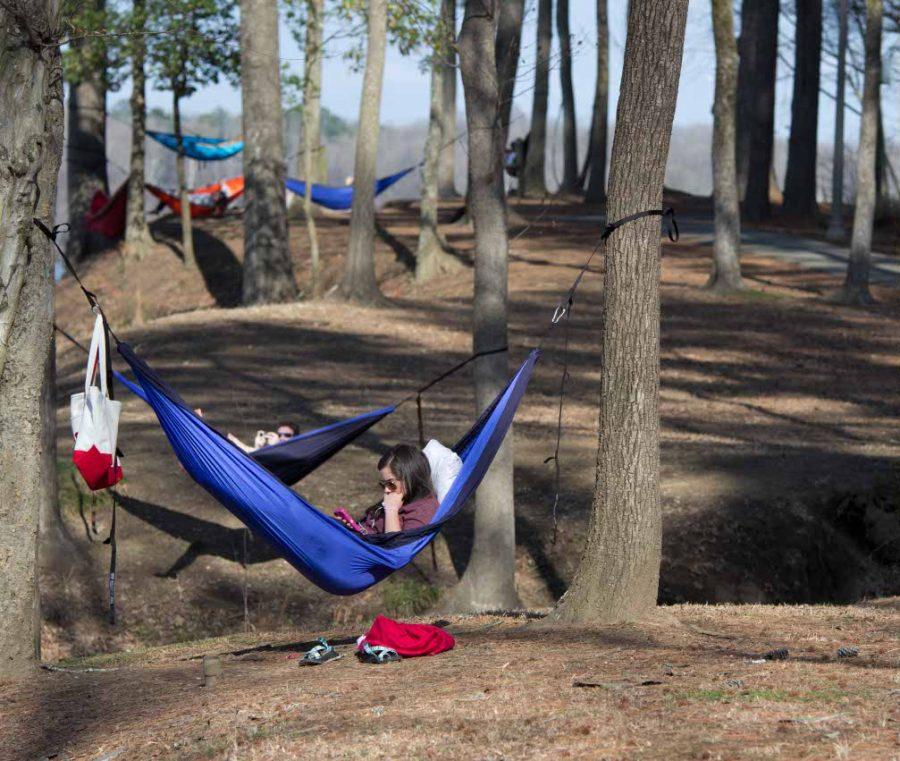With the onset of warmer weather, students begin to repopulate the outdoors, and the trees quickly become adorned with colorful hammocks.
“I call them the hammock villages. People stack them, like, four high between two trees. I love hammocking with other people just because it is such a communal thing,” Sara Walker, a senior majoring in public relations, said. “You don’t have to strictly nap or do anything. Sometimes I’ll just go out with friends and we’ll just chat and chill in the hammock.”
Walker now uses her hammock at home or outside at Lake Nicol to read, study or simply relax. Walker said she believes the fad has developed over recent years from college students working during the summer at various camps and picking up the hobby there, as hammocks are a part of a camping and outdoors culture. Walker herself has been hammocking since camping with her family from a young age.
“If I have to do something, I look at it as, ‘Can I do this in my hammock?’” Walker said. “Would I rather be inside studying or, if I don’t need to be tied to my laptop, I’ll totally just go somewhere and take it with me.”
(See also “Students take advantage of secluded study spots“)
Hammocks made by Eagle’s Nest Outfitters have become particularly popular among students. ENO’s two most basic hammock sizes, SingleNest and DoubleNest, are priced $59.95 and $69.95 without straps, respectively. Hammocks are sold without straps, or the ropes that attach to trees to suspend the hammock. Straps, be they Slap Strap PROs or Atlas Suspension System, range from $24.94 to $29.95.
Walker said one positive aspect of ENOs is their portability, as the hammocks and the straps fold down into small bags. The Atlas Suspension System straps are advertised as being tree friendly and can hold up to 400 lbs.
Erin Smith, a junior majoring in international relations, bought her hammock during her freshman year. Smith has been camping and hiking since her childhood and has found hammocks are an extension of an outdoorsy disposition, despite their initial costs.
“Freshman year I knew a bunch of people who went hammocking, so it was an impulse buy, and I’ve used it so many times since then,” Smith said. “I know a lot of people buy them secondhand or on Ebay. It’s expensive, but I love it, and it’s great.”
After the initial payment for a hammock and straps, many opt for various hammock accessories, such as an Underbelly Gear Sling ($29.95) that holds items like books beneath the hammock, a Guardian Bug Net ($59.95) or a PakPillow Hammock Pillow ($26.00).
“I have the tent cover, so when I go camping I don’t have to bring a tent and a hammock. It’s way more portable. I also have the bug net,” Walker said. “I would say, yes, it is expensive, if you don’t know what you’re looking for. If you’re willing to put in a little research, it can be cheaper.”
While students can hammock in a variety of locations, such as Lake Nicol or Sokol Park, The University of Alabama is not among them. The University has rules dictated by the University Grounds Department which prohibit “ropes, wires, hammocks, slack lines, zip lines, nails, tape and signage” from being hung on university trees, particularly those on the Quad.
(See also “What’s the use?: After updates, grounds use permit poses procedural complications“)
“Having healthy trees is a top priority to keep our campus beautiful. For that reason, misuse of any and all trees is prohibited,” Cathy Andreen, director of Media Relations, said. “Hammocks have caused damage to trees on campus in the past.”
The Park at Manderson Landing, which is property of the University, is included in the prohibition of hammocks. Many hammockers choose to setup on the riverfront just to the west of the park, which is owned by the city of Tuscaloosa, and therefore free game for hammockers.
Steven Johnston, interim superintendent of Landscape Services at Auburn University, said Auburn has a similar policy about hammocks.
“The Auburn University Facilities Management Landscaping Department does not endorse the use of hammocks or any other items attached to the trees on the AU campus. The Landscaping Department has maintained this position for many years,” Johnston said in an emailed statement.
Despite the policy, Elliott Burrow, a freshman majoring in civil engineering at Auburn, said students populate many areas of the campus with hammocks, namely the Haley Center Concourse, an area with heavy pedestrian traffic, with little to no intervention by University officials.
“I’ve seen people hammocking, reading books and stuff. I had no idea we weren’t allowed to,” Burrow said. “I don’t even know who would enforce that kind of thing.”
At The University of Alabama, some students, such as Walker, said they wish they were able to hammock on campus between classes, since good seating on the Quad fills up fast when the temperature rises.
“It’s super unfortunate because I have breaks between classes and it would be great if I could go over, even by Marr’s Spring, and sit in the shade in my hammock and read or take a quick nap, but I can’t do that,” Walker said.
While some students may find the UA policy inconvenient, others said they think being allowed to hammock on campus would almost defeat the purpose of having a hammock.
“For me, it’s [that] I need to get away. I need to feel like I’m not in the city, at school. I need to feel like I’m in nature, as granola as that sounds,” Walker said. “It just gets you back to a more natural place.”
Editor’s note: Corrected on March 4 to clarify that the area west of The Park at Manderson Landing is not owned by the University, and therefore free game for hammockers.
(See also “Campus in bloom“)









